The Kaveri Refresh 'Godavari' Review: Testing AMD's A10-7870K
by Ian Cutress on June 1, 2015 11:59 AM ESTGaming Benchmarks: High End
Alien: Isolation
If first person survival mixed with horror is your sort of thing, then Alien: Isolation, based off of the Alien franchise, should be an interesting title. Developed by The Creative Assembly and released in October 2014, Alien: Isolation has won numerous awards from Game Of The Year to several top 10s/25s and Best Horror titles, ratcheting up over a million sales by February 2015. Alien: Isolation uses a custom built engine which includes dynamic sound effects and should be fully multi-core enabled.
For low end graphics, we test at 720p with Ultra settings, whereas for mid and high range graphics we bump this up to 1080p, taking the average frame rate as our marker with a scripted version of the built-in benchmark.
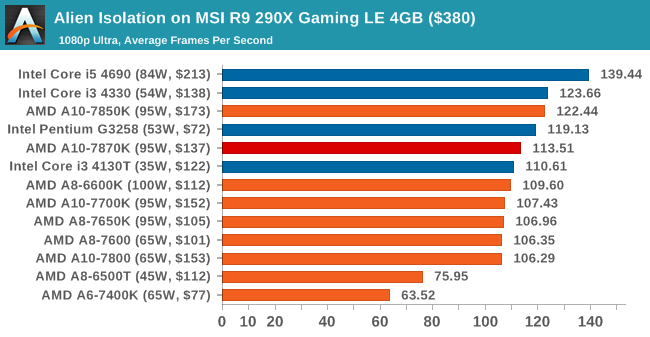

Total War: Attila
The Total War franchise moves on to Attila, another The Creative Assembly development, and is a stand-alone strategy title set in 395AD where the main story line lets the gamer take control of the leader of the Huns in order to conquer parts of the world. Graphically the game can render hundreds/thousands of units on screen at once, all with their individual actions and can put some of the big cards to task.
For low end graphics, we test at 720p with performance settings, recording the average frame rate. With mid and high range graphics, we test at 1080p with the quality setting. In both circumstances, unlimited video memory is enabled and the in-game scripted benchmark is used.

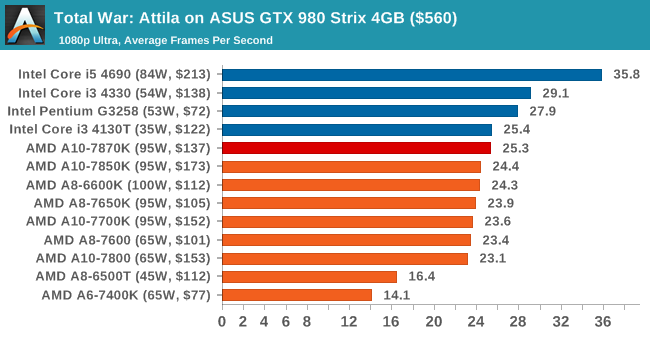
Grand Theft Auto V
The highly anticipated iteration of the Grand Theft Auto franchise finally hit the shelves on April 14th 2015, with both AMD and NVIDIA in tow to help optimize the title. GTA doesn’t provide graphical presets, but opens up the options to users and extends the boundaries by pushing even the hardest systems to the limit using Rockstar’s Advanced Game Engine. Whether the user is flying high in the mountains with long draw distances or dealing with assorted trash in the city, when cranked up to maximum it creates stunning visuals but hard work for both the CPU and the GPU.
For our test we have scripted a version of the in-game benchmark, relying only on the final part which combines a flight scene along with an in-city drive-by followed by a tanker explosion. For low end systems we test at 720p on the lowest settings, whereas mid and high end graphics play at 1080p with very high settings across the board. We record both the average frame rate and the percentage of frames under 60 FPS (16.6ms).
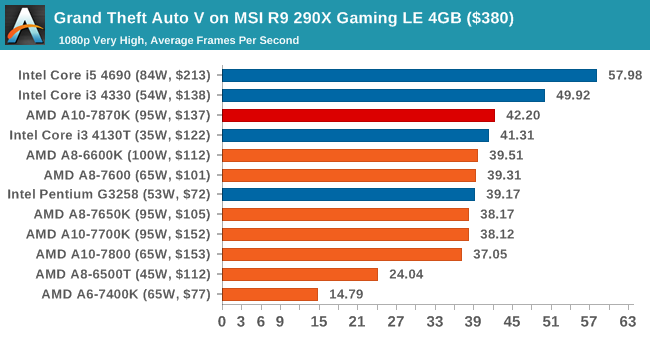
![Grand Theft Auto V on MSI R9 290X Gaming LE 4GB ($380) [Under 60 FPS]](https://images.anandtech.com/graphs/graph9307/74894.png)
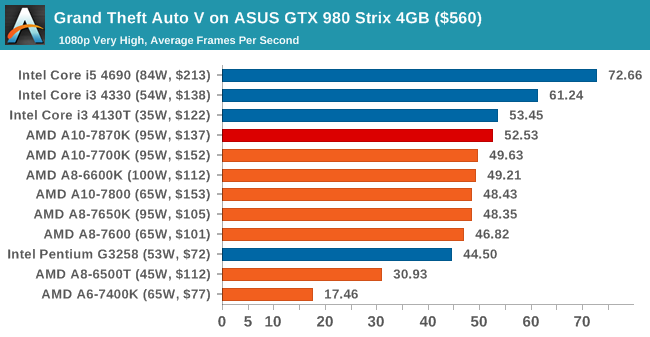
![Grand Theft Auto V on ASUS GTX 980 Strix 4GB ($560) [Under 60 FPS]](https://images.anandtech.com/graphs/graph9307/74906.png)
GRID: Autosport
No graphics tests are complete without some input from Codemasters and the EGO engine, which means for this round of testing we point towards GRID: Autosport, the next iteration in the GRID and racing genre. As with our previous racing testing, each update to the engine aims to add in effects, reflections, detail and realism, with Codemasters making ‘authenticity’ a main focal point for this version.
GRID’s benchmark mode is very flexible, and as a result we created a test race using a shortened version of the Red Bull Ring with twelve cars doing two laps. The car is focus starts last and is quite fast, but usually finishes second or third. For low end graphics we test at 1080p medium settings, whereas mid and high end graphics get the full 1080p maximum. Both the average and minimum frame rates are recorded.
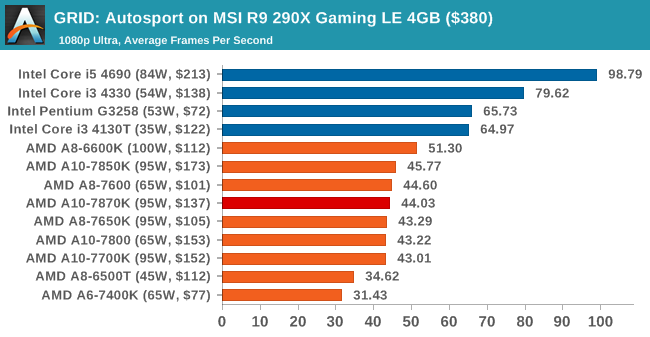
![GRID: Autosport on MSI R9 290X Gaming LE 4GB ($380) [Minimum FPS]](https://images.anandtech.com/graphs/graph9307/74896.png)
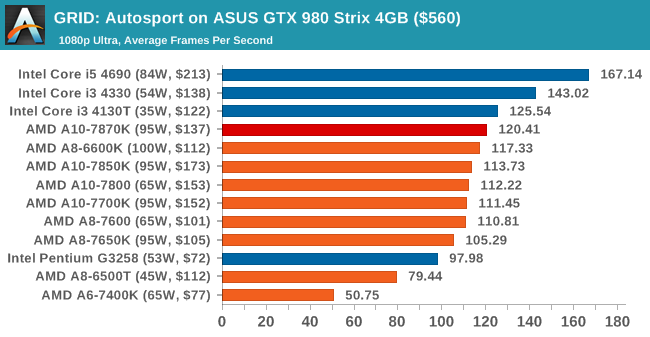
![GRID: Autosport on ASUS GTX 980 Strix 4GB ($560) [Minimum FPS]](https://images.anandtech.com/graphs/graph9307/74908.png)
Middle-Earth: Shadows of Mordor
The final title in our testing is another battle of system performance with the open world action-adventure title, Shadows of Mordor. Produced by Monolith using the LithTech Jupiter EX engine and numerous detail add-ons, SoM goes for detail and complexity to a large extent, despite having to be cut down from the original plans. The main story itself was written by the same writer as Red Dead Redemption, and it received Zero Punctuation’s Game of The Year in 2014.
For testing purposes, SoM gives a dynamic screen resolution setting, allowing us to render at high resolutions that are then scaled down to the monitor. As a result, we get several tests using the in-game benchmark. For low end graphics we examine at 720p with low settings, whereas mid and high end graphics get 1080p Ultra. The top graphics test is also redone at 3840x2160, also with Ultra settings, and we also test two cards at 4K where possible.
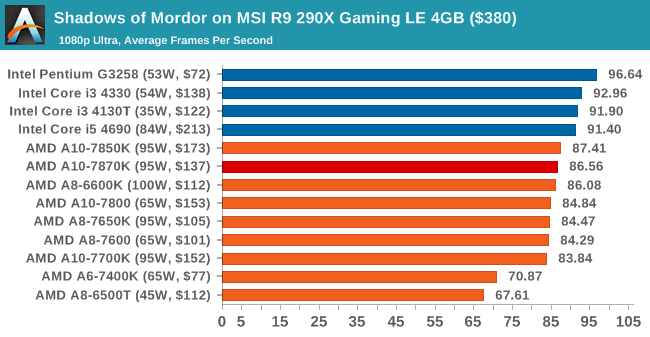
![Shadows of Mordor on MSI R9 290X Gaming LE 4GB ($380) [Minimum FPS]](https://images.anandtech.com/graphs/graph9307/74898.png)
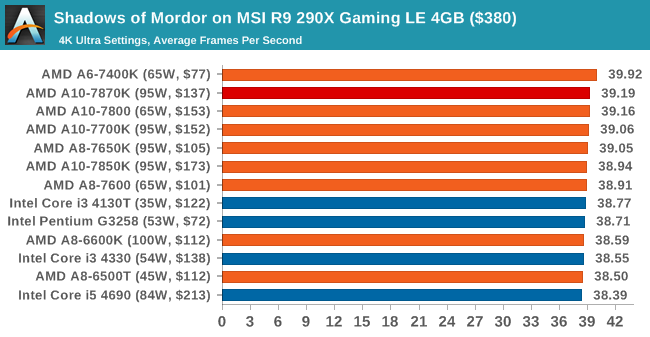
![Shadows of Mordor on MSI R9 290X Gaming LE 4GB ($380) [Minimum FPS]](https://images.anandtech.com/graphs/graph9307/74900.png)
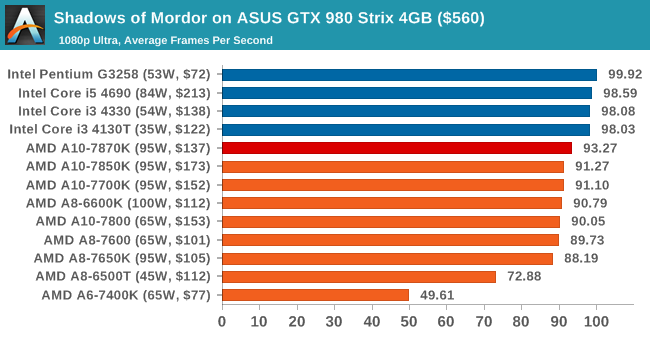
![Shadows of Mordor on ASUS GTX 980 Strix 4GB ($560) [Minimum FPS]](https://images.anandtech.com/graphs/graph9307/74910.png)
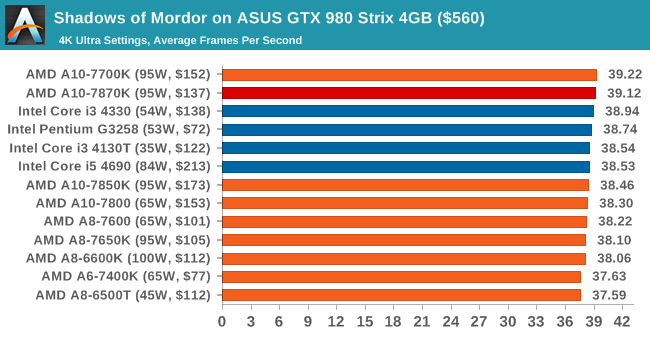
![Shadows of Mordor on ASUS GTX 980 Strix 4GB ($560) [Minimum FPS]](https://images.anandtech.com/graphs/graph9307/74912.png)
Shadows of Mordor, Dual-GPU
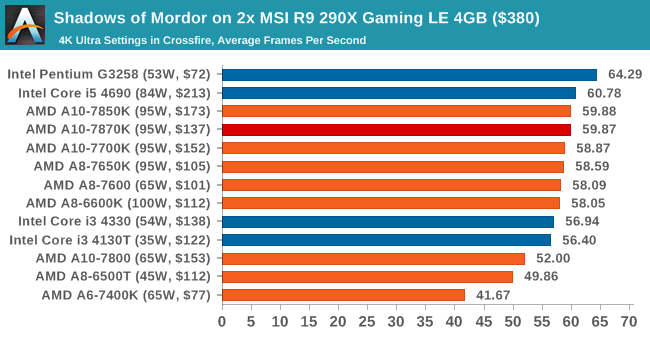
![Shadows of Mordor on 2x MSI R9 290X Gaming LE 4GB ($380) [Minimum FPS]](https://images.anandtech.com/graphs/graph9307/74902.png)
Conclusions on High-End Graphics
Moving to faster GPUs and higher resolutions pushes the burden away from the processor and more onto the graphics cards, so as a result some of the titles here, on some GPU combinations, see little gain moving up through the processor stack. That being said, some titles (like Alien Isolation, GRID and Mordor on a GTX 980) love the horse power under the hood and AMD can have a hard time keeping up here against the blue team. I wouldn’t be surprised if AMD is hoping that DirectX 12 levels the playing field in this regard.















140 Comments
View All Comments
barleyguy - Monday, June 1, 2015 - link
I have an HTPC in a tiny case (mini ITX and only a couple inches tall), powered by an A8-7600. For the price, form factor, and versatility (allows midrange gaming), I feel it was a really good choice.That said, I'm a little bit disappointed in this release, not so much because it's beaten in CPU benchmarks by a more expensive Intel that requires a larger case for a decent GPU, but because the 7870 isn't much faster than the A8-7600. It's more expensive and uses twice the power. (The A8-7600 has a 45W mode. It idles at less than 20 watts and peaks at about 60 watts for the whole system with an SSD.)
Like others have said, I would love an FM2+ Carrizo. Hopefully that would bring noticeably higher performance at the 45W level.
TallestJon96 - Monday, June 1, 2015 - link
This isn't for me, but it seems like these APUs are growing better more quickly than any other CPU or GPU section. Power consumption is a bit high, but if you don't have a dedicated graphics card it definitely manageable.My biggest concern is the slow ram for graphics. This is tested on 2133 ram but the target audience for this will have 1333 or 1600... I'd like to know how much performance changes then.
But it's pretty impressive for the price, and it should suit people who do web browsing, Netflix and light gaming extremely well.
barleyguy - Monday, June 1, 2015 - link
I'm running 2133 on my A8-7600 HTPC. It was only about $10 extra for 4 GB. If the target audience is running 1333 or 1600, it's because they didn't know any better. IMO.nikaldro - Monday, June 1, 2015 - link
If that 2133Mhz RAM has horrible timings, you didn't solve much...barleyguy - Monday, June 1, 2015 - link
It's CAS latency 9, 9-10-9-27, Corsair XMS. Nothing wrong with it.Lolimaster - Tuesday, June 2, 2015 - link
Probably the best all around memory timming for an APU unless you find a really cheap 2600 cl11.movax2 - Monday, June 1, 2015 - link
I made a few calculations in Excel.Let's see.
CPU's performance (Windows only: Office-Web + Pro) on average7870K is 0.11% faster than 7850K! Yes, less than 1%.
GPU performance: +1.2%
One word:
disappointment.
Cryio - Monday, June 1, 2015 - link
How did you make the calculations? Do you have on hand a 7870K and a 7850K? Not to mention 8 GBs of DDR3 2400 ram in dual channel?DrMrLordX - Monday, June 1, 2015 - link
Many recent UEFI versions showing "support for Godavari/Kaveri refresh" overvolt the hell out of these chips. It's no wonder they were showing 117W draw. Some of these UEFI revisions are pushing 1.45v OR MORE!Older Kaveri chips (KA-V1) can do 3.9 ghz with only 1.2v on average. Newer ones (GV-A1; 7870k, 7670k, OEM 8500B) should be able to do it with less. There is NO WAY anyone should be pushing this kind of voltage. Some reviews have shown throttling to 1.6 GHz from the board/cpu being overloaded by sheer heat/power draw from these insane voltages (cpu-world, which updated their results with a new UEFI revision that backed voltage off to "only" 1.45v).
There is obviously more work that needs to be done to bring voltage numbers down for stock and the various turbo states supported by this chip, as well as other Kaveri variants. In the meantime, anyone buying this chip should expect it to turn in better results than the 7850k AND do it with less voltage at the same clockspeed (or the same voltage for slightly higher clocks). Just tweak the voltages manually in the UEFI and things should work great.
Lolimaster - Tuesday, June 2, 2015 - link
Exactly, the extra voltage allowed by AMD goes mainly to the gpu part, 20% clocks.